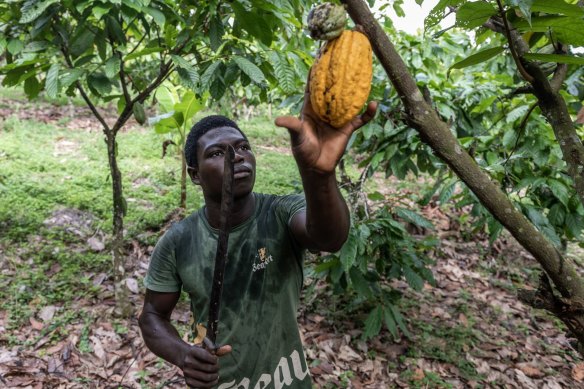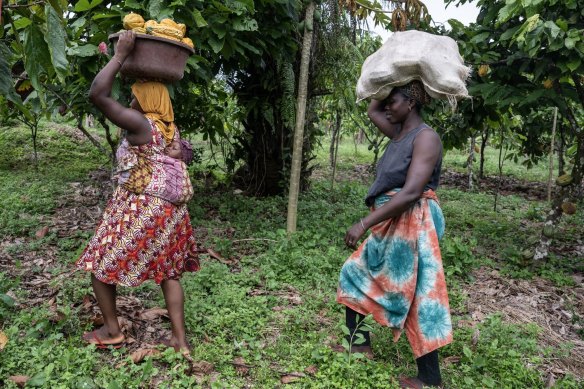A visit to the chocolate aisle of any supermarket can yield a bewildering array of certification logos, each seeking to assure buyers that the cocoa used to make it was produced according to some measure of sustainability.
Labels from groups like the Rainforest Alliance pledge the cocoa inside “was produced by farmers, foresters, and/or companies working together to create a world where people and nature thrive in harmony”. Fair Trade Certified says items bearing its label are made using methods that support social, economic and environmental sustainability.
A worker cuts down cocoa pods from a tree on a farm in Ivory Coast.Credit:Bloomberg
But suppliers and human rights advocates contend a lot of cocoa production is far from sustainable.
Marked by child labour, deforestation and allegations of greenwashing, the industry has arrived at a critical juncture. As demand for cocoa climbs, the African nations where most of it is grown are seeking more compensation for impoverished farmers.
The $US13 billion ($19 billion) cocoa market has been expanding at a steady clip for decades. Asian consumers led by China and India are projected to soon overtake Western Europe in terms of cocoa consumption, according to Singapore-based food ingredients maker Olam Group.
But at the beginning of the supply chain, all is not well. More than two-thirds of the global supply comes from West Africa, and the prices paid to farmers are often rock bottom. Just 6 per cent of the price of a chocolate bar ends up in their hands, according to the Fairtrade Foundation. Some 90 per cent of farmers in Ivory Coast and 70 per cent in Ghana fall below the International Labor Organisation’s poverty threshold of $US2.14 per day.
‘The system (is) designed to give consumers the cheapest possible product and make sure … multinationals are making sufficient profit.’
Last year, Ivory Coast and Ghana increased the price they pay to farmers for their crop at the start of the main harvest by 9 per cent and 21 per cent respectively, but the price hikes failed to offset surging inflation.
“The system has always been designed to give consumers the cheapest possible product and make sure that the large global multinationals are making sufficient profit,” said Antonie Fountain, managing director of Voice Network, an organisation of NGOs and labour unions focused on cocoa sustainability. “But it’s driving extreme poverty at the beginning of the supply chain.” The World Cocoa Foundation, a global industry lobby, didn’t respond to requests for comment.
This dissonance between cocoa industry claims of sustainability and the economic crises faced by many farmers has had a grave knock-on effect for the environment. Cocoa grows in the warm, humid conditions endemic to regions once covered by tropical rainforests. Growers desperate to make enough money to survive have sought to expand their acreage, with disastrous consequences. In Ivory Coast, the world’s top cocoa producer, about 80 per cent of rainforests have been destroyed, much of it to grow cocoa.
“In desperation, the farmer just goes and grows more cocoa,” said Miguel Orellana, whose company Cacao Criollo Arriba makes chocolate sold in Germany with beans grown in Ecuador. “And the way to do that is to destroy more rainforest and plant more cocoa trees.”
Some West African farmers are getting paid below the farm-gate rate for their crop.Credit:Bloomberg
Michael Odijie is a research fellow at University College London who has studied Ivory Coast smallholder farms, from which most of the nation’s cocoa originates. He said the way out of the vicious cycle, both for farmers and the environment, is to pay them a living wage.
“Raising income means they can employ more labour to replant instead of moving into the forest,” Odijie said.
Some consumer giants said they are trying to help farmers boost tree yields by providing both fertiliser and agricultural training. They have developed programs to teach efficient pruning methods or encourage the planting of other crops alongside cocoa.
Growing bananas or mangoes for example helps keep forests intact and increase cocoa crops, since cocoa grows best in the shade of other trees.
Nestle helps pay for trained labourers to assist West African farmers with better growth practices, said Darrell High, who leads the company’s cocoa sustainability strategy. But Odijie said programs such as these, which are also aimed in part at diversifying farmer income, miss a larger point.
“The problem is that to qualify, you have to keep on producing cocoa,” he said.
Ken Giller is a professor in the department of plant sciences at Wageningen University in the Netherlands. He supports company initiatives to improve cocoa yield in a sustainable fashion, though with caveats.
“They often really show great benefits, but it’s impossible for companies to do that for every farmer” because of the expense, he said. So these programs tend to be aimed at larger farms, while smallholders who need the benefits most miss out. Giller also noted that “boosting productivity makes it more attractive to grow cocoa—and therefore more attractive to clear rainforest.”
Farmers making the cocoa crops which end up in chocolate seen on supermarket shelves don’t see enough of the profits, experts say.Credit:AP
Owusu-Addai said he hopes the European Union and US government will step in to help.
“There need to be regulations that will compel these chocolate companies to pay fair prices for cocoa farmers,” Owusu-Addai said.
That might lead to a new label affixed to chocolate bars: Now 20 per cent more expensive.
Bloomberg
Most Viewed in World
From our partners
Source: Read Full Article





